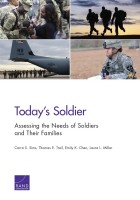| 来源类型 | Research Reports
|
| 规范类型 | 报告
|
| DOI | https://doi.org/10.7249/RR1893
|
| ISBN | 9780833097842
|
| 来源ID | RR-1893-A
|
| Today's Soldier: Assessing the Needs of Soldiers and Their Families |
| Carra S. Sims; Thomas E. Trail; Emily K. Chen; Laura L. Miller
|
| 发表日期 | 2017
|
| 出版年 | 2017
|
| 页码 | 180
|
| 语种 | 英语
|
| 结论 |
Problems with Military Practices and Culture Were the Most Pressing- When asked which problem domains were the most pressing for them, soldiers most frequently reported Military Practices and Culture, followed by Work/Life Balance, Soldier's Own Well-Being, Health Care System Problems, and Relationship Problems.
Soldiers Reported Needing Advice, Activities, and Support- Soldiers who reported needs frequently identified the following needs: advice or education, activities, general information, counseling, and emotional support.
Soldiers Sought Different Kinds of Help from a Variety of Resources, With Generally Satisfactory Results- Of those soldiers who used resources, the majority used both military and nonmilitary resources. Many respondents reported seeking multiple resources.
- Popular military resources accessed by soldiers to address their needs included the chain of command, unit members not in the chain of command, and a doctor or counselor provided by the military.
- Popular nonmilitary resources included personal networks of family and friends and Internet resources.
- In general, both military and nonmilitary resources were rated at or above the midrange of the scale for meeting needs associated with specific problems.
- Reported barriers to resources used by soldiers to address their needs included long wait lists/response time for a military counselor or medical doctor and for child and youth services; the perception that contacting the chain of command might hurt a soldier's career; and the experience of chain of command being unwelcoming or unfriendly.
Soldiers who had one or more unmet needs had worse attitudes toward the Army than did those who accessed resources and had their needs met.
Soldiers who had needs but used no resources had similar attitudes to soldiers who accessed resources and had their needs met.
|
| 摘要 |
- In existing leadership training, discuss negative soldier perceptions regarding the chain of command and the potential consequences of those perceptions. Ensure that leaders know where to refer soldiers for each type of problem so that leaders' own lack of awareness or discomfort with sensitive issues does not lead to an implicit or explicit message to subordinates that they do not want to be approached.
- Seek additional ways to make soldiers and those who assist them more aware of available resources and how to get them. Options include additional training to noncommissioned officers to assist with navigation; additional marketing of Army Community Service and Army OneSource as one-stop referral sources; ensuring that resource providers are aware of other available resources for referrals; and communicating to soldiers about available services using email announcements and social media posts from unit leaders.
- Improve user navigation of resources and coordination among resources to improve efficiency. It may be possible to leverage existing program staff or enhance existing program descriptions to better assist users as they seek out military services to help meet their needs.
- Increase capacity for childcare, professional counseling and medical care. Although some of the barriers reported are not new issues, such as long wait times at Child and Youth Services and military treatment facilities, our survey results suggest that they are still persistent issues for soldiers and their families.
- Partner with civilian systems to address health care demand. Well-known models for partnering with the civilian health care system already exist, and our findings suggest it may be worthwhile exploring the policies necessary to facilitate these types of collaborations at the installation and regional level.
|
| 主题 | Health and Wellness Promotion
; Military Health and Health Care
; Military Personnel Retention
; Military Spouses
; Survey Research Methodology
; United States Army
|
| URL | https://www.rand.org/pubs/research_reports/RR1893.html
|
| 来源智库 | RAND Corporation (United States)
|
| 引用统计 |
|
| 资源类型 | 智库出版物
|
| 条目标识符 | http://119.78.100.153/handle/2XGU8XDN/108585
|
推荐引用方式
GB/T 7714 |
Carra S. Sims,Thomas E. Trail,Emily K. Chen,et al. Today's Soldier: Assessing the Needs of Soldiers and Their Families. 2017.
|
|
文件名:
|
x1507552472982.jpg
|
|
格式:
|
JPEG
|

|
文件名:
|
RAND_RR1893.pdf
|
|
格式:
|
Adobe PDF
|
除非特别说明,本系统中所有内容都受版权保护,并保留所有权利。